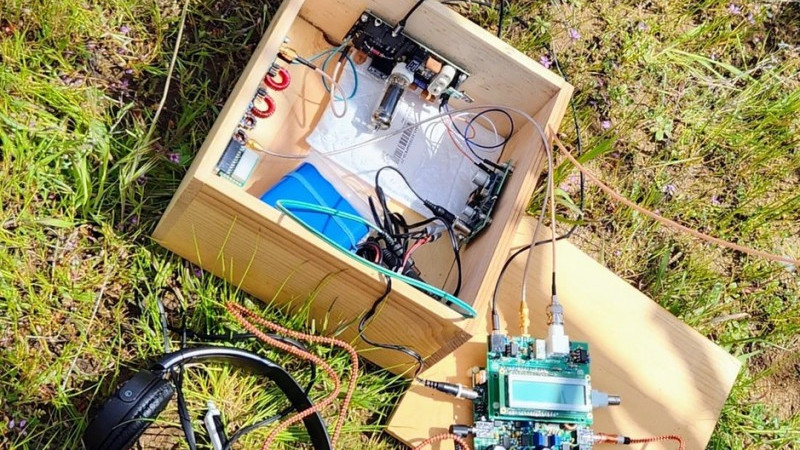One of the more popular trends in the ham radio community right now is operating away from the shack. Parks on the Air (POTA) is an excellent way to take a mobile radio off-grid and operate in the beauty of nature, but for those who want to take their rig to more extreme locations there’s another operating award program called Summits on the Air (SOTA) that requires the radio operator to set up a station on a mountaintop instead. This often requires lightweight, low-power radios to keep weight down for the hike, and [Dan] aka [AI6XG] has created a radio from scratch to do just that.
[Dan] is also a vacuum tube and CW (continuous wave/Morse code) operator on top of his interest in summiting various mountains, so this build incorporates all of his interests. Most vacuum tubes take a lot of energy to operate, but he dug up a circuit from 1967 that uses a single tube which can operate from a 12 volt battery instead of needing mains power, thanks to some help from a more modern switch-mode power supply (SMPS). The SMPS took a bit of research, though, in order to find one that wouldn’t interfere with the radio’s operation. That plus a few other modern tweaks like a QCX interface and a switch to toggle between receive to transmit easily allows this radio to be quite versatile when operating while maintaining its portability and durability when summiting.
For those looking to replicate a tube-based radio like this one, [Dan] has made all of the schematics available on his GitHub page. The only other limitation to keep in mind with a build like this is that it tends to only work on a very narrow range of frequencies without adding further complexity to the design, in this case within the CW portion of the 40-meter band. But that’s not really a bad thing as most radios with these design principles tend to work this way. For some other examples, take a look at these antique QRP radios for operating using an absolute minimum of power.
















CW? Useless.
If you like the old stuff, better use a spark transmitter.
We’re going to get to the year 3000 and some will still be on CW. It’s time to let him die.
Okay, CW on a spark gap it is then. No tuning coil either btw :^)
CW is not possible on a sparky. Yes, they both use Morse but spark and CW are different methods of generating an RF signal.
I’m more worried that in 3000 hams will still think tubes are hot stuff
well, they literally are ;-)
Nah, they are nothing. Nada.
Oh come on, people still shoot arrows and speak Latin, let people enjoy their hobbies.
Wait, what? CW + spark transmitter? YMMD! 😂
@Leonardo, troll much? Leonardo seems like a very old name. Perhaps we should let that drop into oblivion as well. Those that lack the ability to see the utility of various communication means–even CW–demonstrate an extraordinary lack of insight regarding basic concepts.
Leonardo, you’re an obvious troll. Go back to Twitter or something.
CW useless? So thought the US military but the MOS has been reinstated. There are times when CW is the only choice that is practical. Yes, I am aware of the digital modes that can get through with less power. But when you need to improvise a means of communication that is also efficient, CW is what you want. You can build a receiver and transmitter with the guts of two modern light bulbs. Try that with any other mode.
Further, as was demonstrated on national TV, Morse is more efficient for communications than a SMS message on your smart phone, without the major infrastructure the smart phone needs.
You leave me with a difficult choice… Are you a troll or merely one of those unable to learn Morse because you convinced yourself that it is too hard? Or maybe both?
And even if it should become a remembrance of times past, what gives you the right to bad mouth those that enjoy it?
I hope you remember that when your stuck in a submarine and a rescue diver is tapping on the hull…
This is an awesome project. Well done to Dan!
Tubes … sort of. That picture has an awful lot of solid state in it. I think tube designs are fun, but he’s propping up this application with a very large solid state crutch.
Very nice layout.And BTW, I have been a Ham since 1974 and still prefer CW and tubes or discrete transistors over the modern modes and tech any day. 73 de WA4JAT
A “B” battery for driving the plate is about the size of the typical 12v AA pack, if they are still around. but an audio transformer with a vibrator switch mafe from a automotive relay does still work no silicon required
As long as the vibrator has synchronous rectifier contacts instead of those newfangled solid state diodes.
Come on now. Didn’t TFA say it was a design from the 60s? I’m thinking selenium rectifiers.
“propping up this application with a very large solid state crutch”
Yep— he is.